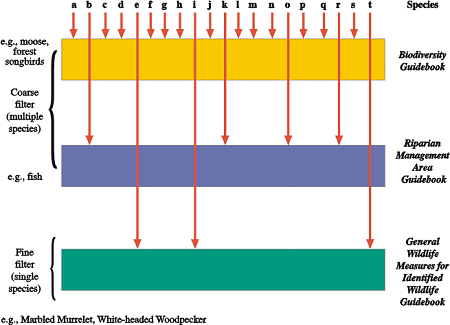1.9 Second approach to forest management
Species-specific or fine filter approach
The second approach to forest management is called fine filter management or species-specific management. This approach is necessary where practices forest-level, coarse-filter practices do not meet the needs of a particular species or a unique vegetation community.
Practices for maintaining large diameter Ponderosa pine as habitat for White-headed Woodpecker is an example of fine filter management. The fine filter approach protects the critical habitat for specie's needs.
Attempts to determine the critical needs for a species, and then to apply management practices to provide these needs. We should assess these practices to see if they:
- Are well suited to endangered or rare species
- Are suitable for species with special values
- (May) create conflicts for species with incompatible needs
- Do not address ecosystem function of a species
The habitat needs of many species are still unknown. Management designed to maintain individual species (fine filter approach) is required when a broad-brush ecosystem approach does not meet the specific habitat needs of the species of concern.
See Figure 5. Relationship between Biodiversity Guidebook and other guidebooks.
This is especially true for species at risk (those that are rare, threatened or endangered, or regionally important) and may require special efforts or practices to protect or maintain their habitats.
Examples of fine filter approaches include:
- Protecting key natal ponds for Tiger Salamander
- Managing large diameter ponderosa pine for White-headed Woodpecker
- Managing coastal old-growth reserves for Marbled Murrelet
- Managing old-growth, closed canopy forests for Northern Goshawk nest areas
What are the differences between coarse filter and fine filter approaches?
When identified wildlife is thought to occur in the operational area, determine which identified wildlife is present using the guide Identified Wildlife Management Strategy.
What are the advantages and disadvantages of implementing the coarse filter & fine filter approaches as two approaches to forest management?
Review management objectives and practices. In the absence of species-specific guidelines, consult regional biologists and existing management plans. The fine filter approach, however, is not suitable as a general biodiversity management strategy. In any given area, there would be far too many species to manage each on an individual basis. In addition, individual species usually have very different habitat requirements and needs. Consequently, management practices that benefit one species may be detrimental to another.
How do the fine filter and coarse filter approaches work together?
Single species habitat needs require habitat management prescriptions specific to them. These are addressed using the fine filter approach. The coarse filter approach provides practices for the habitat for many species. This combination of applying both the coarse and fine filter approaches is designed to ensure habitats for all species are maintained.
See Figure 5. Relationship between Biodiversity Guidebook and other guidebooks (left).
Figure 5: This conceptual diagram illustrates how the recommended practices in the different guidebooks are designed to ensure that the critical requirements of all species are protected. The practices in the Biodiversity and Riparian Management Area guidebooks act as the coarse filter, protecting most species. The practices in the General Wildlife Measures for Identified Wildlife Guidebook act as the fine filter, protecting those species whose habitat requirements are not adequately covered by the coarse filter guidelines.




